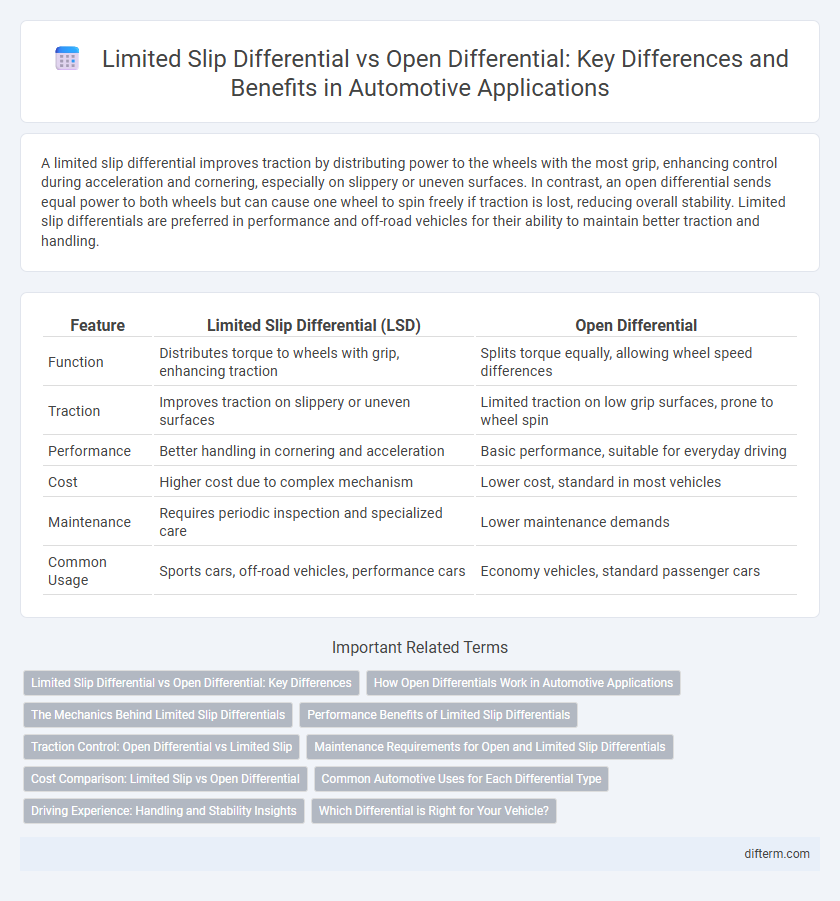A limited slip differential improves traction by distributing power to the wheels with the most grip, enhancing control during acceleration and cornering, especially on slippery or uneven surfaces. In contrast, an open differential sends equal power to both wheels but can cause one wheel to spin freely if traction is lost, reducing overall stability. Limited slip differentials are preferred in performance and off-road vehicles for their ability to maintain better traction and handling.
Table of Comparison
| Feature | Limited Slip Differential (LSD) | Open Differential |
|---|---|---|
| Function | Distributes torque to wheels with grip, enhancing traction | Splits torque equally, allowing wheel speed differences |
| Traction | Improves traction on slippery or uneven surfaces | Limited traction on low grip surfaces, prone to wheel spin |
| Performance | Better handling in cornering and acceleration | Basic performance, suitable for everyday driving |
| Cost | Higher cost due to complex mechanism | Lower cost, standard in most vehicles |
| Maintenance | Requires periodic inspection and specialized care | Lower maintenance demands |
| Common Usage | Sports cars, off-road vehicles, performance cars | Economy vehicles, standard passenger cars |
Limited Slip Differential vs Open Differential: Key Differences
Limited slip differentials (LSD) provide improved traction by distributing torque to the wheel with more grip, enhancing vehicle stability during acceleration and cornering. Open differentials allow wheels to rotate independently, which can lead to loss of traction on slippery surfaces as power is sent to the wheel with less resistance. LSDs are preferred in performance and off-road vehicles for better handling, while open differentials are common in standard passenger cars due to lower complexity and cost.
How Open Differentials Work in Automotive Applications
Open differentials distribute torque equally to both wheels while allowing them to rotate at different speeds, essential during cornering. This mechanism uses a set of spider gears to accommodate variations in wheel speed, improving traction on even surfaces. However, open differentials can struggle with traction on slippery or uneven terrain because torque transfers to the wheel with the least resistance.
The Mechanics Behind Limited Slip Differentials
Limited slip differentials (LSD) use clutch packs, viscous fluids, or helical gears to redistribute torque between wheels when slip occurs, enhancing traction and stability. Unlike open differentials that split torque equally but allow free wheel rotation under low grip, LSDs modulate power delivery to the wheel with more traction. This mechanical advantage improves handling and performance in variable road conditions by reducing wheel spin and maintaining consistent power transfer.
Performance Benefits of Limited Slip Differentials
Limited slip differentials enhance vehicle performance by distributing torque more effectively between the wheels, improving traction on slippery or uneven surfaces. Unlike open differentials, limited slip systems reduce wheel spin during acceleration, resulting in better stability and cornering control. This torque management leads to improved handling, increased power delivery efficiency, and greater driver confidence, especially in high-performance and off-road applications.
Traction Control: Open Differential vs Limited Slip
Limited slip differentials enhance traction control by distributing torque to the wheel with the most grip, preventing excessive wheel spin in low-traction conditions. Open differentials send equal torque to both wheels, causing loss of traction when one wheel slips or lifts. Vehicles equipped with limited slip differentials maintain better stability and control on slippery or uneven surfaces compared to those with open differentials.
Maintenance Requirements for Open and Limited Slip Differentials
Limited slip differentials require regular inspection of clutch packs or viscous couplings, and often need specialized gear oil with friction modifiers to maintain optimal performance. Open differentials have simpler maintenance routines, primarily focusing on routine gear oil changes to prevent wear and corrosion. Neglecting proper lubrication in either differential type can lead to premature failure and costly repairs.
Cost Comparison: Limited Slip vs Open Differential
Limited slip differentials typically cost between $400 and $1,200, reflecting their advanced design and enhanced traction capabilities compared to open differentials, which generally range from $150 to $400. The higher price of limited slip differentials is justified by improved performance in cornering and off-road conditions, reducing wheel slippage and enhancing vehicle control. Maintenance costs for limited slip units may be slightly higher due to more complex components, but the investment often results in better durability and driving safety.
Common Automotive Uses for Each Differential Type
Limited slip differentials are commonly used in performance cars and off-road vehicles to provide improved traction by distributing torque to the wheel with the most grip, enhancing cornering stability and control. Open differentials are typically found in standard passenger cars and light trucks, offering smooth drivability and better fuel efficiency by allowing wheels to rotate at different speeds during turns, though they may struggle in low-traction conditions. The choice between limited slip and open differentials hinges on vehicle application, with limited slip favored for sporty and rugged use, while open differentials suit everyday driving on paved roads.
Driving Experience: Handling and Stability Insights
Limited slip differentials enhance driving experience by improving traction and stability during cornering, distributing torque efficiently between wheels to minimize wheel slip. Open differentials provide basic torque distribution but can cause reduced control and stability in low-traction conditions, leading to wheel spin. Vehicles equipped with limited slip differentials consistently deliver better handling, especially in performance and off-road driving scenarios, by maintaining optimal grip and balance.
Which Differential is Right for Your Vehicle?
Choosing the right differential depends on your vehicle's intended use and driving conditions. A limited slip differential improves traction by distributing power to the wheel with the most grip, ideal for performance cars, off-road vehicles, and slippery conditions. In contrast, an open differential provides optimal handling and smoother turns on dry pavement but may struggle with traction on uneven or slippery surfaces.
limited slip differential vs open differential Infographic

 difterm.com
difterm.com